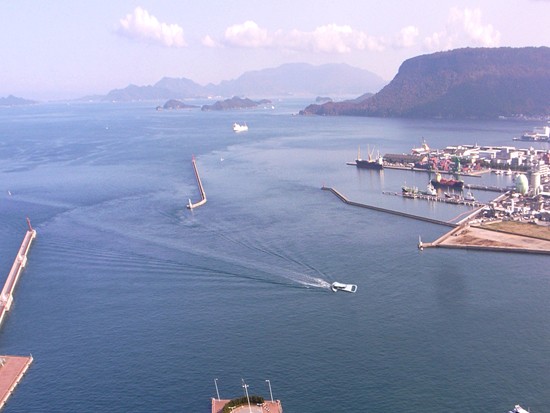 Yasuhiro Suzuki – Ship of the Zipper (2010) Megijima, rendering. Courtesy the Setouchi International Art Festival.
Yasuhiro Suzuki – Ship of the Zipper (2010) Megijima, rendering. Courtesy the Setouchi International Art Festival.(Naoshima) On July 19, Japan’s newest art festival opened to the public. Sprawling across seven islands in the Seto Inland Sea as well as the Takamatsu Port area on the island of Shikoku and the Uno Port area on the mainland, the Setouchi International Art Festival is the latest large-scale event in Japan to explore the possibilities of community renewal through art.
The Inland Sea is already famous for the contemporary art treasure island of Naoshima, where the private Naoshima Fukutake Art Museum Foundation has backed the construction of facilities such as the Tadao Ando-designed Chichu Art Museum and commissioned site-specific installations by artists including Tatsuo Miyajima, Hiroshi Sugimoto and James Turrell. Taking the theme “Utilize existing elements, and create elements that do not exist” and featuring more than 75 participating artists and groups, the festival, which is sponsored primarily by the foundation, has expanded this model to Naoshima’s neighboring islands.
Highlights include the unveiling of a permanent home for French artist Christian Boltanksi’s Les Archives du Coeur (The Heart Archive), an archive of recordings of heartbeats of people from around the world, as well as a permanent installation of works by Rei Naito, known for minimalist sculptural works using materials such as thread and running water, in a white, teardrop-shaped building designed by architect Ryue Nishizawa, a partner in the firm SANAA. Both projects are on the island of Teshima, which has an estimated population of 1,000 people and covers an area of roughly 14 square-kilometers. The lead-up to the festival also saw the June 15 public opening of a Tadao Ando-designed museum dedicated to Korea-born Mono-ha artist Lee Ufan and the July 2009 opening of a public bathhouse designed by artist Shinro Ohtake in collaboration with the architectural firm graf, both on Naoshima.
However, the festival is not solely dedicated to extravagant architectural development. On Inujima, where the island’s population has declined to less than 1/50th of its peak of more than 3,000 people, a former copper refinery will provide the backdrop for a purpose-built stage for the core of the festival’s performance program, while other activities include music events and a three-day symposium that will be held in August across sites on multiple islands. A relic of a once-thriving copper-refining industry, the refinery itself was painstakingly refurbished using local materials and eco-friendly technology by the architect Hiroshi Sambuichi. It opened in 2008 as a home for an immersive installation by the artist Yukinori Yanagi, who is premiering the second phase of the “Inujima Art Project” – this time in collaboration with Kazuyo Sejima of SANAA – at the festival.
Meanwhile, the island of Megijima, population 200, is hosting the quasi-commercial project Fukutake House, for which 13 galleries hailing from China, France, Germany, Japan, Korea, Mexico and the US are presenting newly commissioned works in a former schoolhouse. These include Kurimanzutto’s (Mexico) presentation of Mexican artist Gabriel Kuri’s minimal, sculptural interventions, Stripped Columns (2010), and Vitamin Creative Space’s (Guangzhou/Beijing) presentation of Austrian artist Jun Yang’s video Phantom Island (2010).
The Fukutake House project debuted at the 2006 Echigo-Tsumari Art Triennial in Niigata, and is not the only carryover between the festival and triennial, as both events share the same general director, Fram Kitagawa. Both events are situated in the context of Japan’s rural population flight and economic decline, and both seek to transform abandoned infrastructure into sites for artistic creation that can in turn attract tourist-generated income to hard-pressed communities.
Kitagawa told ART iT that he viewed the festival as a way to infuse energy into the islands and the local environment. “Through the attraction of art and architecture, we can invigorate the lifestyle and customs of the islands as well as the elderly men and women who live here and even the sea life,” he said. “Working together we can all enjoy, delight in and be moved by what is the world’s largest such festival.”
The Naoshima Fukutake Art Museum Foundation’s interest in revitalizing the island communities is in part related to the foundation’s namesake and president, Soichiro Fukutake, whose Benesse Corporation is headquartered in the city of Okayama on the mainland next to the Seto Inland Sea. One of Japan’s wealthiest men, Fukutake started his first project on Naoshima in 1989 and has continued adding to the island’s cultural inventory since then.
Billed as a “100-day Art and Sea Adventure,” the festival continues through October 31.
Related:
Defining a Proposal Through Questions: Jun Yang on the Taipei Contemporary Art Center
